HR0372 Culture and Organisation: An Analysis of Uniqlo's Culture
VerifiedAdded on 2023/06/10
|14
|4125
|211
Report
AI Summary
This report offers a detailed analysis of Uniqlo's organizational culture, focusing on its practices, values, and beliefs within a retail context. It utilizes Edgar Schein's three-level framework, examining artifacts, values and beliefs, and underlying assumptions to understand Uniqlo's unique culture and its competitive advantages. The report explores the company's history, business model, and strategies, including its customer focus, innovation, and price strategies. The analysis includes how Uniqlo maintains its brand equity and the cultural links between the company and its customers. The report justifies the choice of Schein's framework over Hofstede's, emphasizing its relevance to organizational culture. The analysis also highlights the importance of customer service, innovation, and price strategies in shaping the company's culture.
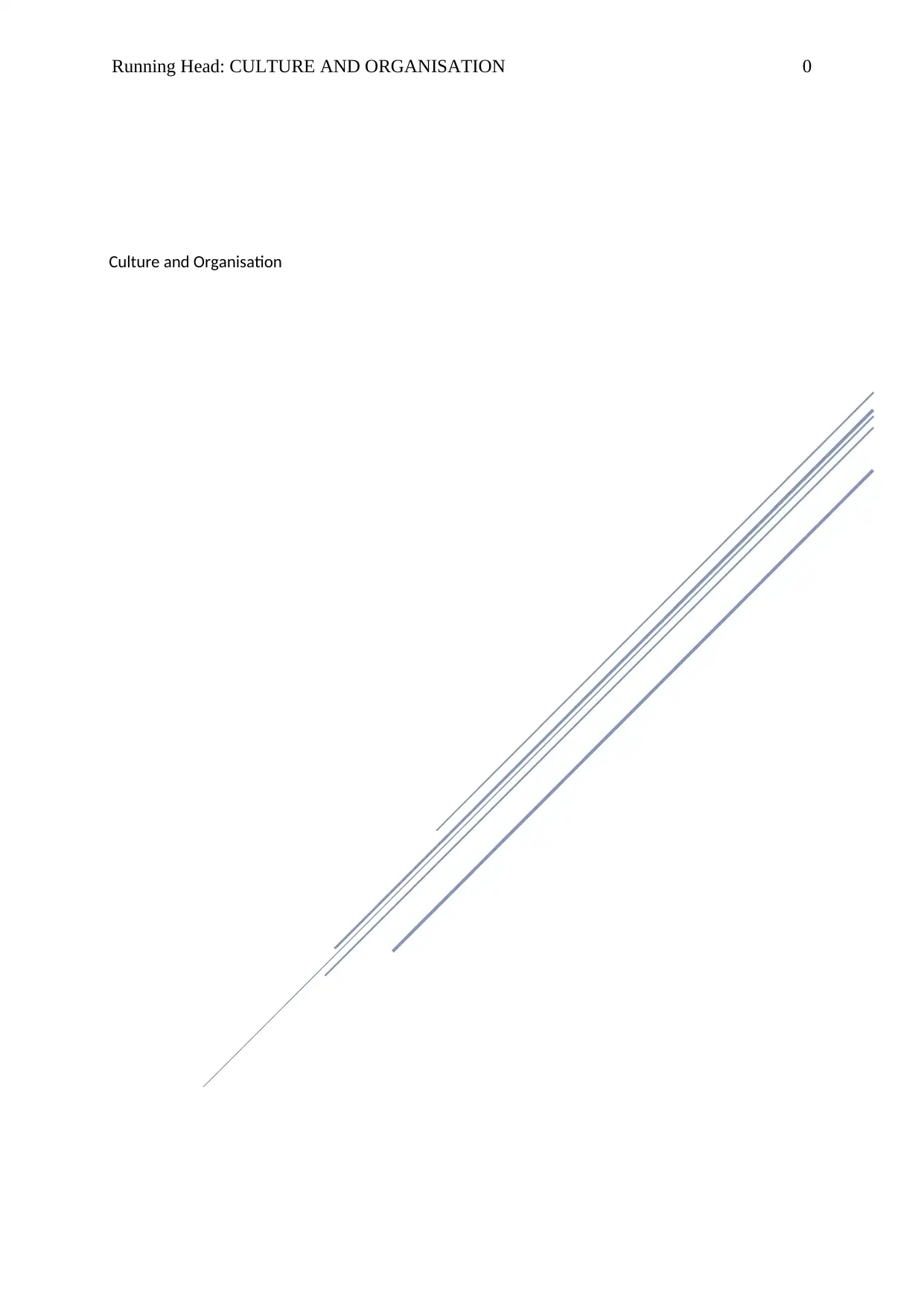
Running Head: CULTURE AND ORGANISATION 0
Culture and Organisation
Culture and Organisation
Paraphrase This Document
Need a fresh take? Get an instant paraphrase of this document with our AI Paraphraser
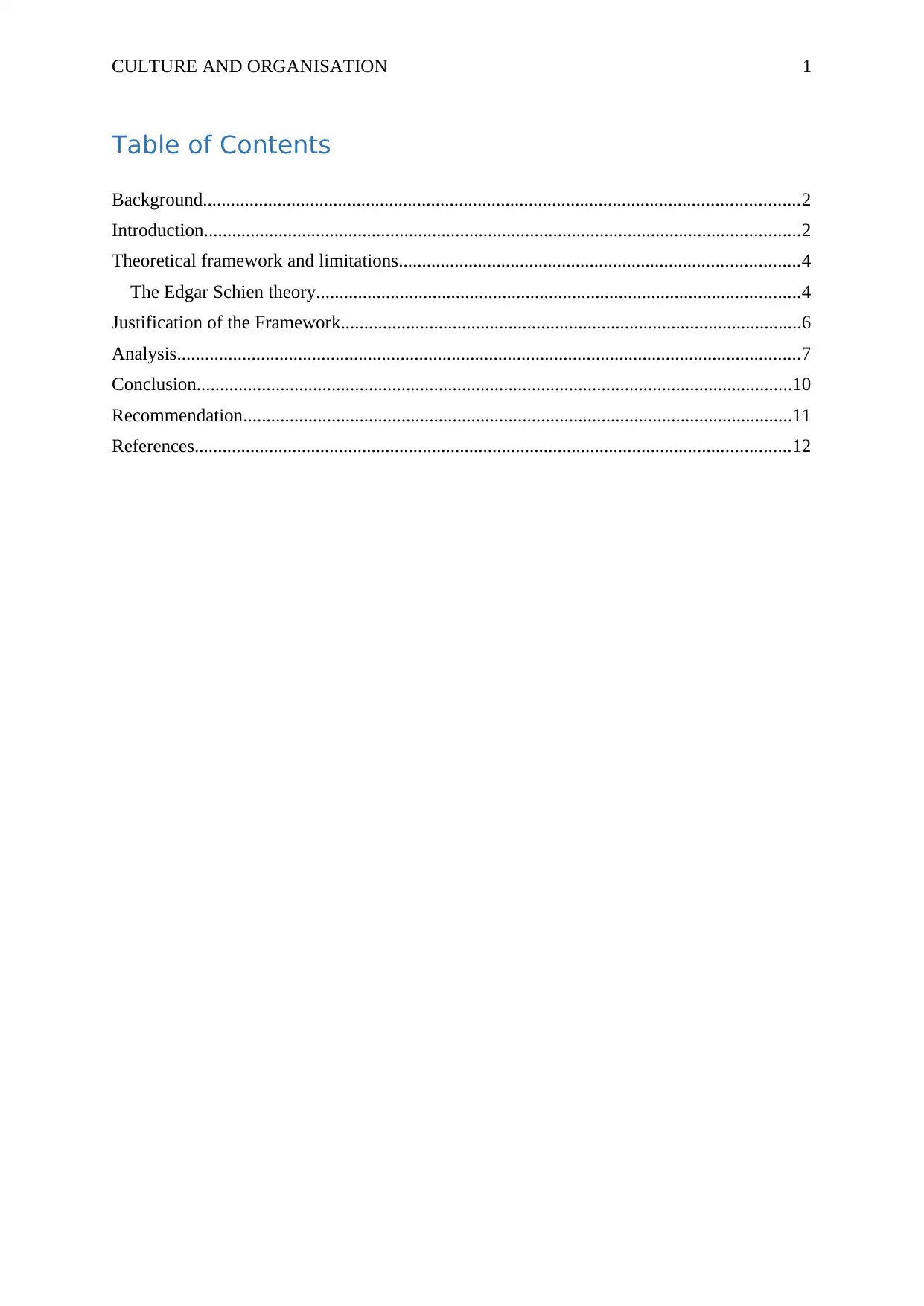
CULTURE AND ORGANISATION 1
Table of Contents
Background................................................................................................................................2
Introduction................................................................................................................................2
Theoretical framework and limitations......................................................................................4
The Edgar Schien theory........................................................................................................4
Justification of the Framework...................................................................................................6
Analysis......................................................................................................................................7
Conclusion................................................................................................................................10
Recommendation......................................................................................................................11
References................................................................................................................................12
Table of Contents
Background................................................................................................................................2
Introduction................................................................................................................................2
Theoretical framework and limitations......................................................................................4
The Edgar Schien theory........................................................................................................4
Justification of the Framework...................................................................................................6
Analysis......................................................................................................................................7
Conclusion................................................................................................................................10
Recommendation......................................................................................................................11
References................................................................................................................................12
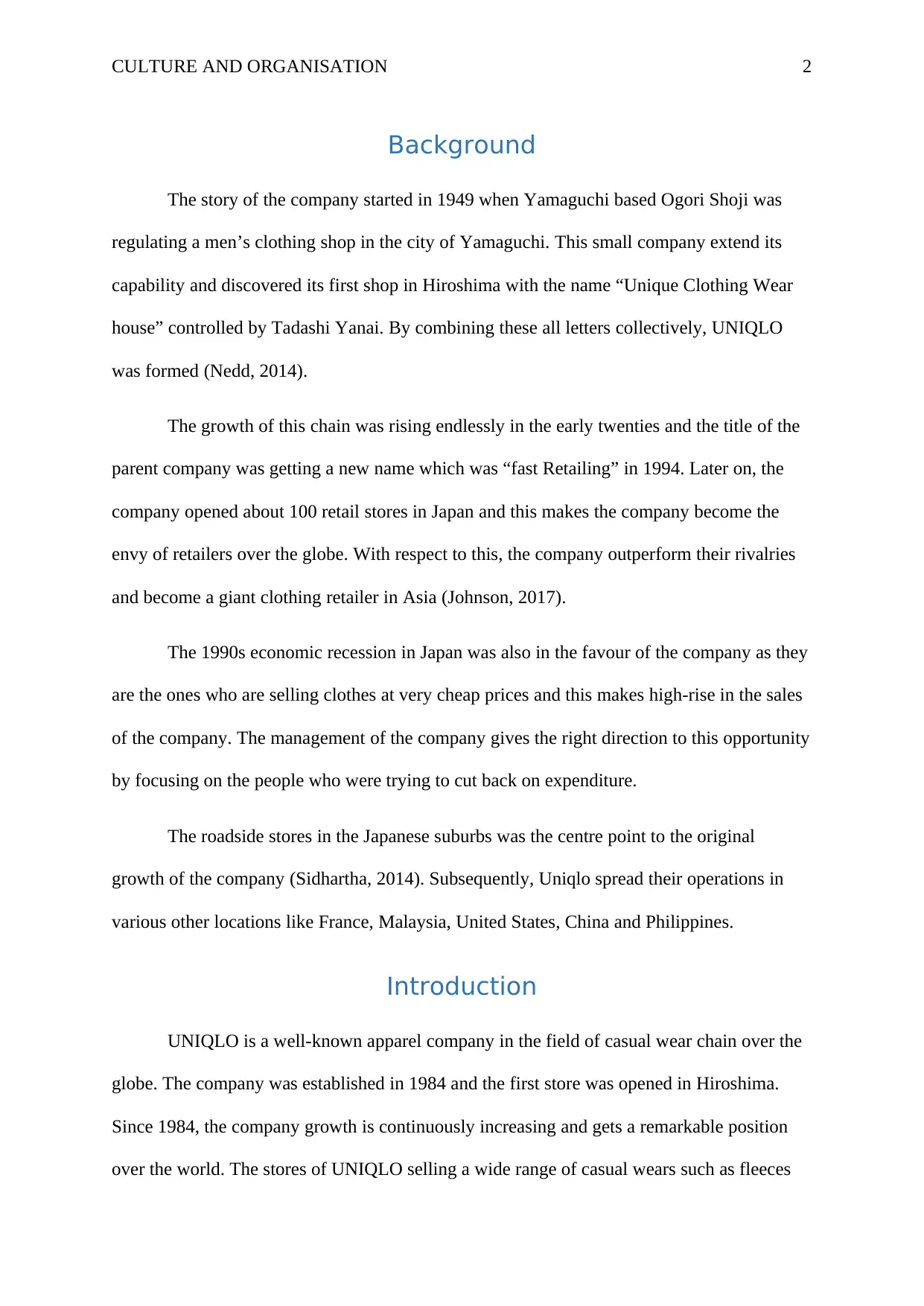
CULTURE AND ORGANISATION 2
Background
The story of the company started in 1949 when Yamaguchi based Ogori Shoji was
regulating a men’s clothing shop in the city of Yamaguchi. This small company extend its
capability and discovered its first shop in Hiroshima with the name “Unique Clothing Wear
house” controlled by Tadashi Yanai. By combining these all letters collectively, UNIQLO
was formed (Nedd, 2014).
The growth of this chain was rising endlessly in the early twenties and the title of the
parent company was getting a new name which was “fast Retailing” in 1994. Later on, the
company opened about 100 retail stores in Japan and this makes the company become the
envy of retailers over the globe. With respect to this, the company outperform their rivalries
and become a giant clothing retailer in Asia (Johnson, 2017).
The 1990s economic recession in Japan was also in the favour of the company as they
are the ones who are selling clothes at very cheap prices and this makes high-rise in the sales
of the company. The management of the company gives the right direction to this opportunity
by focusing on the people who were trying to cut back on expenditure.
The roadside stores in the Japanese suburbs was the centre point to the original
growth of the company (Sidhartha, 2014). Subsequently, Uniqlo spread their operations in
various other locations like France, Malaysia, United States, China and Philippines.
Introduction
UNIQLO is a well-known apparel company in the field of casual wear chain over the
globe. The company was established in 1984 and the first store was opened in Hiroshima.
Since 1984, the company growth is continuously increasing and gets a remarkable position
over the world. The stores of UNIQLO selling a wide range of casual wears such as fleeces
Background
The story of the company started in 1949 when Yamaguchi based Ogori Shoji was
regulating a men’s clothing shop in the city of Yamaguchi. This small company extend its
capability and discovered its first shop in Hiroshima with the name “Unique Clothing Wear
house” controlled by Tadashi Yanai. By combining these all letters collectively, UNIQLO
was formed (Nedd, 2014).
The growth of this chain was rising endlessly in the early twenties and the title of the
parent company was getting a new name which was “fast Retailing” in 1994. Later on, the
company opened about 100 retail stores in Japan and this makes the company become the
envy of retailers over the globe. With respect to this, the company outperform their rivalries
and become a giant clothing retailer in Asia (Johnson, 2017).
The 1990s economic recession in Japan was also in the favour of the company as they
are the ones who are selling clothes at very cheap prices and this makes high-rise in the sales
of the company. The management of the company gives the right direction to this opportunity
by focusing on the people who were trying to cut back on expenditure.
The roadside stores in the Japanese suburbs was the centre point to the original
growth of the company (Sidhartha, 2014). Subsequently, Uniqlo spread their operations in
various other locations like France, Malaysia, United States, China and Philippines.
Introduction
UNIQLO is a well-known apparel company in the field of casual wear chain over the
globe. The company was established in 1984 and the first store was opened in Hiroshima.
Since 1984, the company growth is continuously increasing and gets a remarkable position
over the world. The stores of UNIQLO selling a wide range of casual wears such as fleeces
⊘ This is a preview!⊘
Do you want full access?
Subscribe today to unlock all pages.

Trusted by 1+ million students worldwide
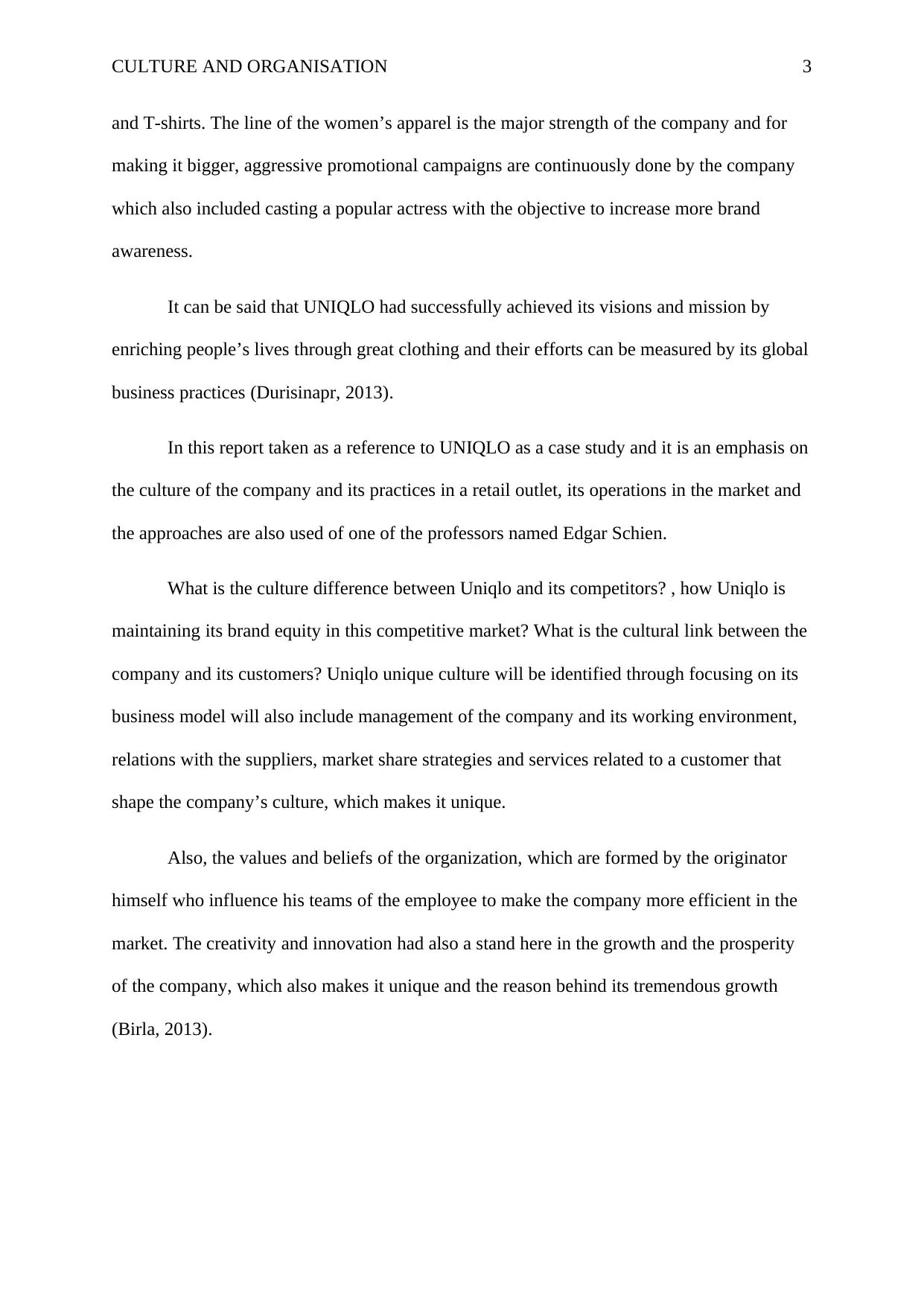
CULTURE AND ORGANISATION 3
and T-shirts. The line of the women’s apparel is the major strength of the company and for
making it bigger, aggressive promotional campaigns are continuously done by the company
which also included casting a popular actress with the objective to increase more brand
awareness.
It can be said that UNIQLO had successfully achieved its visions and mission by
enriching people’s lives through great clothing and their efforts can be measured by its global
business practices (Durisinapr, 2013).
In this report taken as a reference to UNIQLO as a case study and it is an emphasis on
the culture of the company and its practices in a retail outlet, its operations in the market and
the approaches are also used of one of the professors named Edgar Schien.
What is the culture difference between Uniqlo and its competitors? , how Uniqlo is
maintaining its brand equity in this competitive market? What is the cultural link between the
company and its customers? Uniqlo unique culture will be identified through focusing on its
business model will also include management of the company and its working environment,
relations with the suppliers, market share strategies and services related to a customer that
shape the company’s culture, which makes it unique.
Also, the values and beliefs of the organization, which are formed by the originator
himself who influence his teams of the employee to make the company more efficient in the
market. The creativity and innovation had also a stand here in the growth and the prosperity
of the company, which also makes it unique and the reason behind its tremendous growth
(Birla, 2013).
and T-shirts. The line of the women’s apparel is the major strength of the company and for
making it bigger, aggressive promotional campaigns are continuously done by the company
which also included casting a popular actress with the objective to increase more brand
awareness.
It can be said that UNIQLO had successfully achieved its visions and mission by
enriching people’s lives through great clothing and their efforts can be measured by its global
business practices (Durisinapr, 2013).
In this report taken as a reference to UNIQLO as a case study and it is an emphasis on
the culture of the company and its practices in a retail outlet, its operations in the market and
the approaches are also used of one of the professors named Edgar Schien.
What is the culture difference between Uniqlo and its competitors? , how Uniqlo is
maintaining its brand equity in this competitive market? What is the cultural link between the
company and its customers? Uniqlo unique culture will be identified through focusing on its
business model will also include management of the company and its working environment,
relations with the suppliers, market share strategies and services related to a customer that
shape the company’s culture, which makes it unique.
Also, the values and beliefs of the organization, which are formed by the originator
himself who influence his teams of the employee to make the company more efficient in the
market. The creativity and innovation had also a stand here in the growth and the prosperity
of the company, which also makes it unique and the reason behind its tremendous growth
(Birla, 2013).
Paraphrase This Document
Need a fresh take? Get an instant paraphrase of this document with our AI Paraphraser
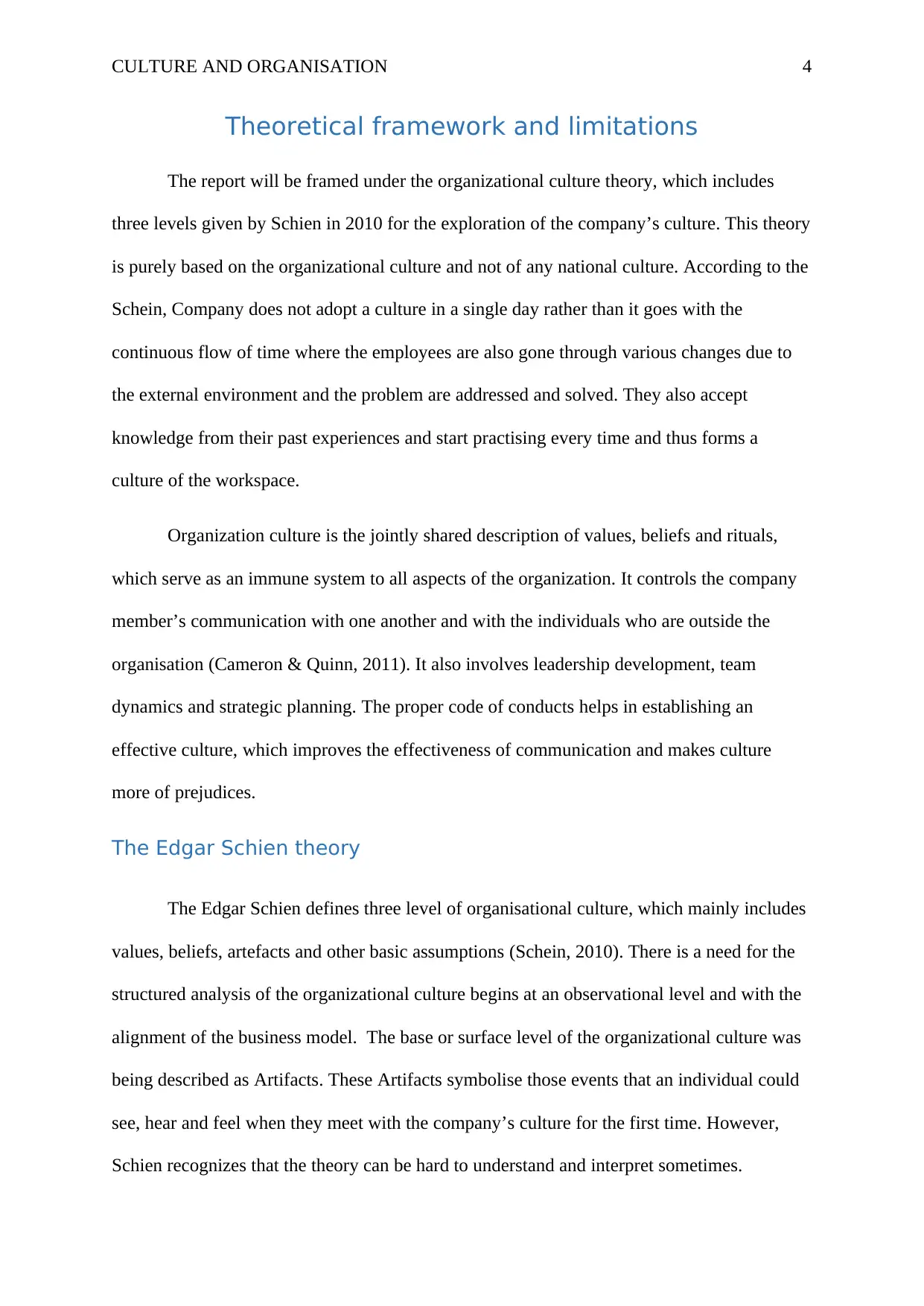
CULTURE AND ORGANISATION 4
Theoretical framework and limitations
The report will be framed under the organizational culture theory, which includes
three levels given by Schien in 2010 for the exploration of the company’s culture. This theory
is purely based on the organizational culture and not of any national culture. According to the
Schein, Company does not adopt a culture in a single day rather than it goes with the
continuous flow of time where the employees are also gone through various changes due to
the external environment and the problem are addressed and solved. They also accept
knowledge from their past experiences and start practising every time and thus forms a
culture of the workspace.
Organization culture is the jointly shared description of values, beliefs and rituals,
which serve as an immune system to all aspects of the organization. It controls the company
member’s communication with one another and with the individuals who are outside the
organisation (Cameron & Quinn, 2011). It also involves leadership development, team
dynamics and strategic planning. The proper code of conducts helps in establishing an
effective culture, which improves the effectiveness of communication and makes culture
more of prejudices.
The Edgar Schien theory
The Edgar Schien defines three level of organisational culture, which mainly includes
values, beliefs, artefacts and other basic assumptions (Schein, 2010). There is a need for the
structured analysis of the organizational culture begins at an observational level and with the
alignment of the business model. The base or surface level of the organizational culture was
being described as Artifacts. These Artifacts symbolise those events that an individual could
see, hear and feel when they meet with the company’s culture for the first time. However,
Schien recognizes that the theory can be hard to understand and interpret sometimes.
Theoretical framework and limitations
The report will be framed under the organizational culture theory, which includes
three levels given by Schien in 2010 for the exploration of the company’s culture. This theory
is purely based on the organizational culture and not of any national culture. According to the
Schein, Company does not adopt a culture in a single day rather than it goes with the
continuous flow of time where the employees are also gone through various changes due to
the external environment and the problem are addressed and solved. They also accept
knowledge from their past experiences and start practising every time and thus forms a
culture of the workspace.
Organization culture is the jointly shared description of values, beliefs and rituals,
which serve as an immune system to all aspects of the organization. It controls the company
member’s communication with one another and with the individuals who are outside the
organisation (Cameron & Quinn, 2011). It also involves leadership development, team
dynamics and strategic planning. The proper code of conducts helps in establishing an
effective culture, which improves the effectiveness of communication and makes culture
more of prejudices.
The Edgar Schien theory
The Edgar Schien defines three level of organisational culture, which mainly includes
values, beliefs, artefacts and other basic assumptions (Schein, 2010). There is a need for the
structured analysis of the organizational culture begins at an observational level and with the
alignment of the business model. The base or surface level of the organizational culture was
being described as Artifacts. These Artifacts symbolise those events that an individual could
see, hear and feel when they meet with the company’s culture for the first time. However,
Schien recognizes that the theory can be hard to understand and interpret sometimes.
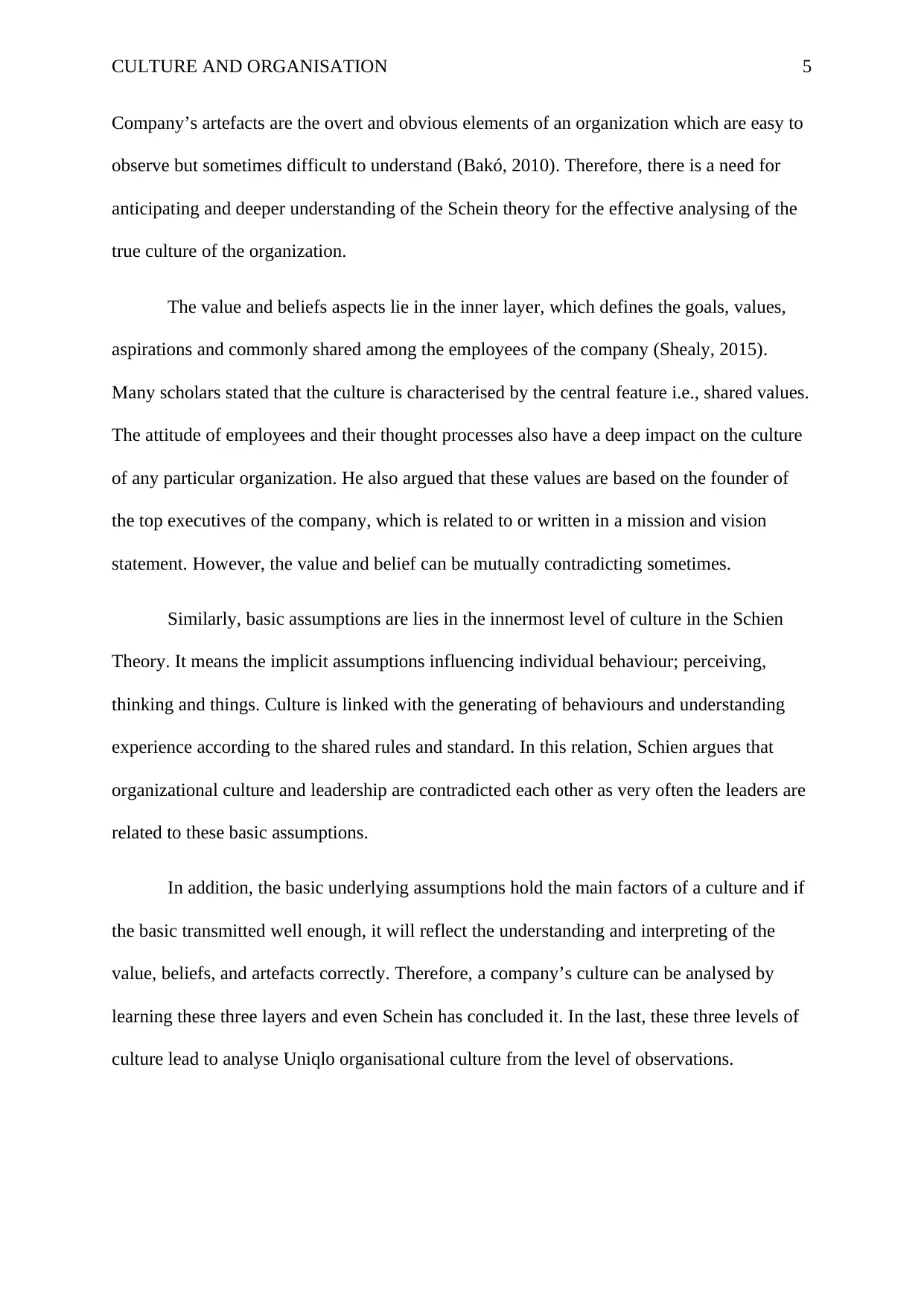
CULTURE AND ORGANISATION 5
Company’s artefacts are the overt and obvious elements of an organization which are easy to
observe but sometimes difficult to understand (Bakó, 2010). Therefore, there is a need for
anticipating and deeper understanding of the Schein theory for the effective analysing of the
true culture of the organization.
The value and beliefs aspects lie in the inner layer, which defines the goals, values,
aspirations and commonly shared among the employees of the company (Shealy, 2015).
Many scholars stated that the culture is characterised by the central feature i.e., shared values.
The attitude of employees and their thought processes also have a deep impact on the culture
of any particular organization. He also argued that these values are based on the founder of
the top executives of the company, which is related to or written in a mission and vision
statement. However, the value and belief can be mutually contradicting sometimes.
Similarly, basic assumptions are lies in the innermost level of culture in the Schien
Theory. It means the implicit assumptions influencing individual behaviour; perceiving,
thinking and things. Culture is linked with the generating of behaviours and understanding
experience according to the shared rules and standard. In this relation, Schien argues that
organizational culture and leadership are contradicted each other as very often the leaders are
related to these basic assumptions.
In addition, the basic underlying assumptions hold the main factors of a culture and if
the basic transmitted well enough, it will reflect the understanding and interpreting of the
value, beliefs, and artefacts correctly. Therefore, a company’s culture can be analysed by
learning these three layers and even Schein has concluded it. In the last, these three levels of
culture lead to analyse Uniqlo organisational culture from the level of observations.
Company’s artefacts are the overt and obvious elements of an organization which are easy to
observe but sometimes difficult to understand (Bakó, 2010). Therefore, there is a need for
anticipating and deeper understanding of the Schein theory for the effective analysing of the
true culture of the organization.
The value and beliefs aspects lie in the inner layer, which defines the goals, values,
aspirations and commonly shared among the employees of the company (Shealy, 2015).
Many scholars stated that the culture is characterised by the central feature i.e., shared values.
The attitude of employees and their thought processes also have a deep impact on the culture
of any particular organization. He also argued that these values are based on the founder of
the top executives of the company, which is related to or written in a mission and vision
statement. However, the value and belief can be mutually contradicting sometimes.
Similarly, basic assumptions are lies in the innermost level of culture in the Schien
Theory. It means the implicit assumptions influencing individual behaviour; perceiving,
thinking and things. Culture is linked with the generating of behaviours and understanding
experience according to the shared rules and standard. In this relation, Schien argues that
organizational culture and leadership are contradicted each other as very often the leaders are
related to these basic assumptions.
In addition, the basic underlying assumptions hold the main factors of a culture and if
the basic transmitted well enough, it will reflect the understanding and interpreting of the
value, beliefs, and artefacts correctly. Therefore, a company’s culture can be analysed by
learning these three layers and even Schein has concluded it. In the last, these three levels of
culture lead to analyse Uniqlo organisational culture from the level of observations.
⊘ This is a preview!⊘
Do you want full access?
Subscribe today to unlock all pages.

Trusted by 1+ million students worldwide
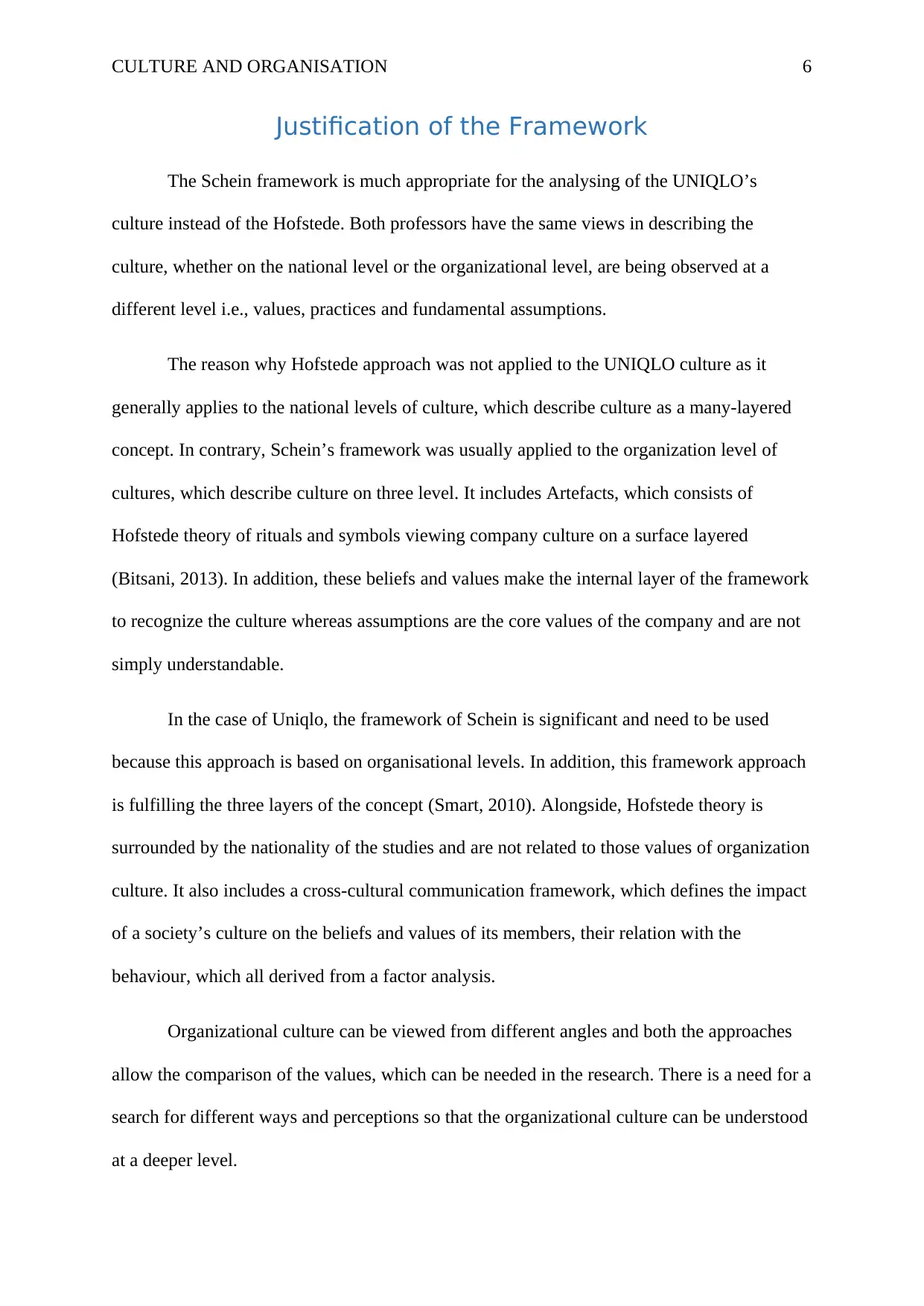
CULTURE AND ORGANISATION 6
Justification of the Framework
The Schein framework is much appropriate for the analysing of the UNIQLO’s
culture instead of the Hofstede. Both professors have the same views in describing the
culture, whether on the national level or the organizational level, are being observed at a
different level i.e., values, practices and fundamental assumptions.
The reason why Hofstede approach was not applied to the UNIQLO culture as it
generally applies to the national levels of culture, which describe culture as a many-layered
concept. In contrary, Schein’s framework was usually applied to the organization level of
cultures, which describe culture on three level. It includes Artefacts, which consists of
Hofstede theory of rituals and symbols viewing company culture on a surface layered
(Bitsani, 2013). In addition, these beliefs and values make the internal layer of the framework
to recognize the culture whereas assumptions are the core values of the company and are not
simply understandable.
In the case of Uniqlo, the framework of Schein is significant and need to be used
because this approach is based on organisational levels. In addition, this framework approach
is fulfilling the three layers of the concept (Smart, 2010). Alongside, Hofstede theory is
surrounded by the nationality of the studies and are not related to those values of organization
culture. It also includes a cross-cultural communication framework, which defines the impact
of a society’s culture on the beliefs and values of its members, their relation with the
behaviour, which all derived from a factor analysis.
Organizational culture can be viewed from different angles and both the approaches
allow the comparison of the values, which can be needed in the research. There is a need for a
search for different ways and perceptions so that the organizational culture can be understood
at a deeper level.
Justification of the Framework
The Schein framework is much appropriate for the analysing of the UNIQLO’s
culture instead of the Hofstede. Both professors have the same views in describing the
culture, whether on the national level or the organizational level, are being observed at a
different level i.e., values, practices and fundamental assumptions.
The reason why Hofstede approach was not applied to the UNIQLO culture as it
generally applies to the national levels of culture, which describe culture as a many-layered
concept. In contrary, Schein’s framework was usually applied to the organization level of
cultures, which describe culture on three level. It includes Artefacts, which consists of
Hofstede theory of rituals and symbols viewing company culture on a surface layered
(Bitsani, 2013). In addition, these beliefs and values make the internal layer of the framework
to recognize the culture whereas assumptions are the core values of the company and are not
simply understandable.
In the case of Uniqlo, the framework of Schein is significant and need to be used
because this approach is based on organisational levels. In addition, this framework approach
is fulfilling the three layers of the concept (Smart, 2010). Alongside, Hofstede theory is
surrounded by the nationality of the studies and are not related to those values of organization
culture. It also includes a cross-cultural communication framework, which defines the impact
of a society’s culture on the beliefs and values of its members, their relation with the
behaviour, which all derived from a factor analysis.
Organizational culture can be viewed from different angles and both the approaches
allow the comparison of the values, which can be needed in the research. There is a need for a
search for different ways and perceptions so that the organizational culture can be understood
at a deeper level.
Paraphrase This Document
Need a fresh take? Get an instant paraphrase of this document with our AI Paraphraser
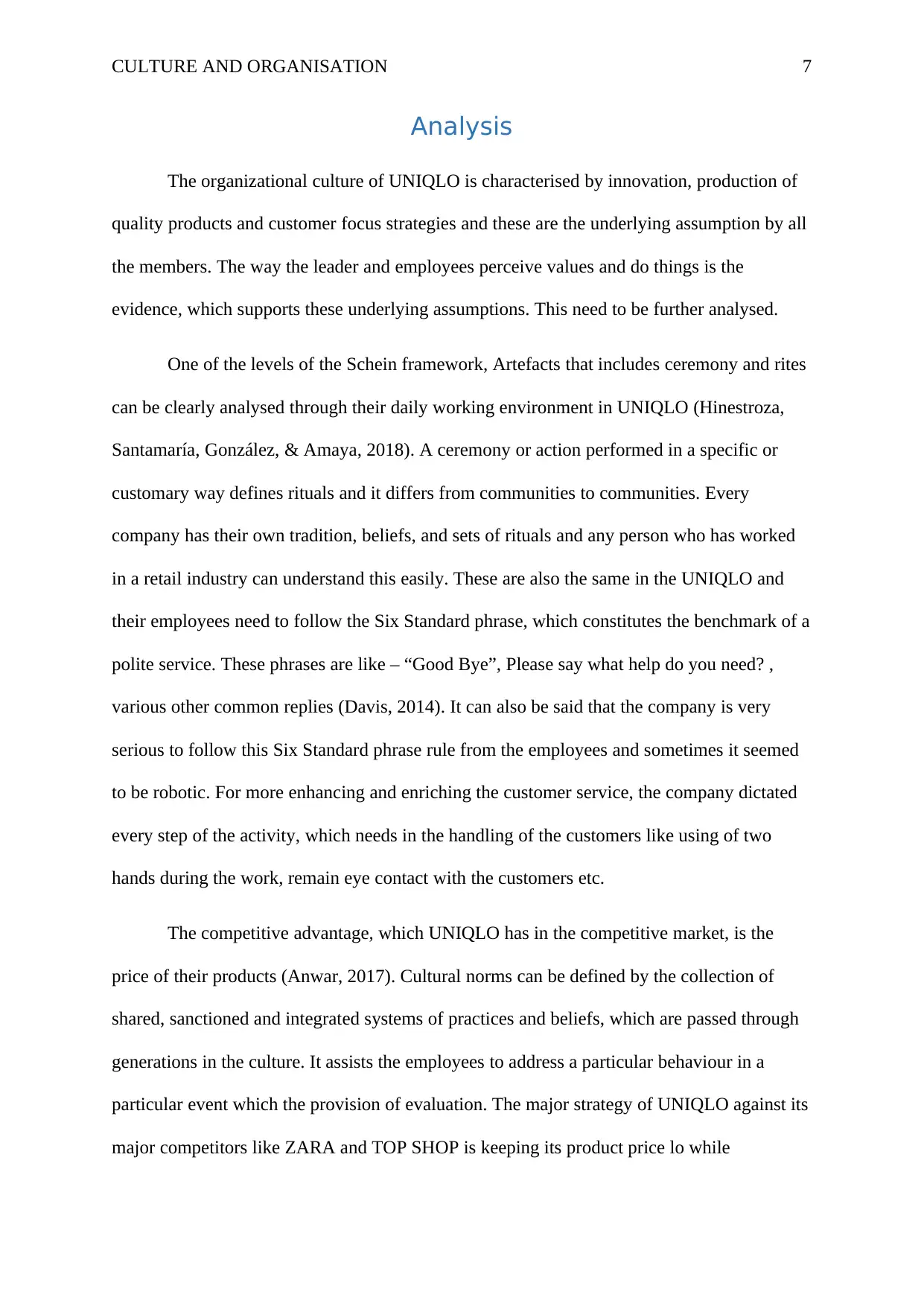
CULTURE AND ORGANISATION 7
Analysis
The organizational culture of UNIQLO is characterised by innovation, production of
quality products and customer focus strategies and these are the underlying assumption by all
the members. The way the leader and employees perceive values and do things is the
evidence, which supports these underlying assumptions. This need to be further analysed.
One of the levels of the Schein framework, Artefacts that includes ceremony and rites
can be clearly analysed through their daily working environment in UNIQLO (Hinestroza,
Santamaría, González, & Amaya, 2018). A ceremony or action performed in a specific or
customary way defines rituals and it differs from communities to communities. Every
company has their own tradition, beliefs, and sets of rituals and any person who has worked
in a retail industry can understand this easily. These are also the same in the UNIQLO and
their employees need to follow the Six Standard phrase, which constitutes the benchmark of a
polite service. These phrases are like – “Good Bye”, Please say what help do you need? ,
various other common replies (Davis, 2014). It can also be said that the company is very
serious to follow this Six Standard phrase rule from the employees and sometimes it seemed
to be robotic. For more enhancing and enriching the customer service, the company dictated
every step of the activity, which needs in the handling of the customers like using of two
hands during the work, remain eye contact with the customers etc.
The competitive advantage, which UNIQLO has in the competitive market, is the
price of their products (Anwar, 2017). Cultural norms can be defined by the collection of
shared, sanctioned and integrated systems of practices and beliefs, which are passed through
generations in the culture. It assists the employees to address a particular behaviour in a
particular event which the provision of evaluation. The major strategy of UNIQLO against its
major competitors like ZARA and TOP SHOP is keeping its product price lo while
Analysis
The organizational culture of UNIQLO is characterised by innovation, production of
quality products and customer focus strategies and these are the underlying assumption by all
the members. The way the leader and employees perceive values and do things is the
evidence, which supports these underlying assumptions. This need to be further analysed.
One of the levels of the Schein framework, Artefacts that includes ceremony and rites
can be clearly analysed through their daily working environment in UNIQLO (Hinestroza,
Santamaría, González, & Amaya, 2018). A ceremony or action performed in a specific or
customary way defines rituals and it differs from communities to communities. Every
company has their own tradition, beliefs, and sets of rituals and any person who has worked
in a retail industry can understand this easily. These are also the same in the UNIQLO and
their employees need to follow the Six Standard phrase, which constitutes the benchmark of a
polite service. These phrases are like – “Good Bye”, Please say what help do you need? ,
various other common replies (Davis, 2014). It can also be said that the company is very
serious to follow this Six Standard phrase rule from the employees and sometimes it seemed
to be robotic. For more enhancing and enriching the customer service, the company dictated
every step of the activity, which needs in the handling of the customers like using of two
hands during the work, remain eye contact with the customers etc.
The competitive advantage, which UNIQLO has in the competitive market, is the
price of their products (Anwar, 2017). Cultural norms can be defined by the collection of
shared, sanctioned and integrated systems of practices and beliefs, which are passed through
generations in the culture. It assists the employees to address a particular behaviour in a
particular event which the provision of evaluation. The major strategy of UNIQLO against its
major competitors like ZARA and TOP SHOP is keeping its product price lo while
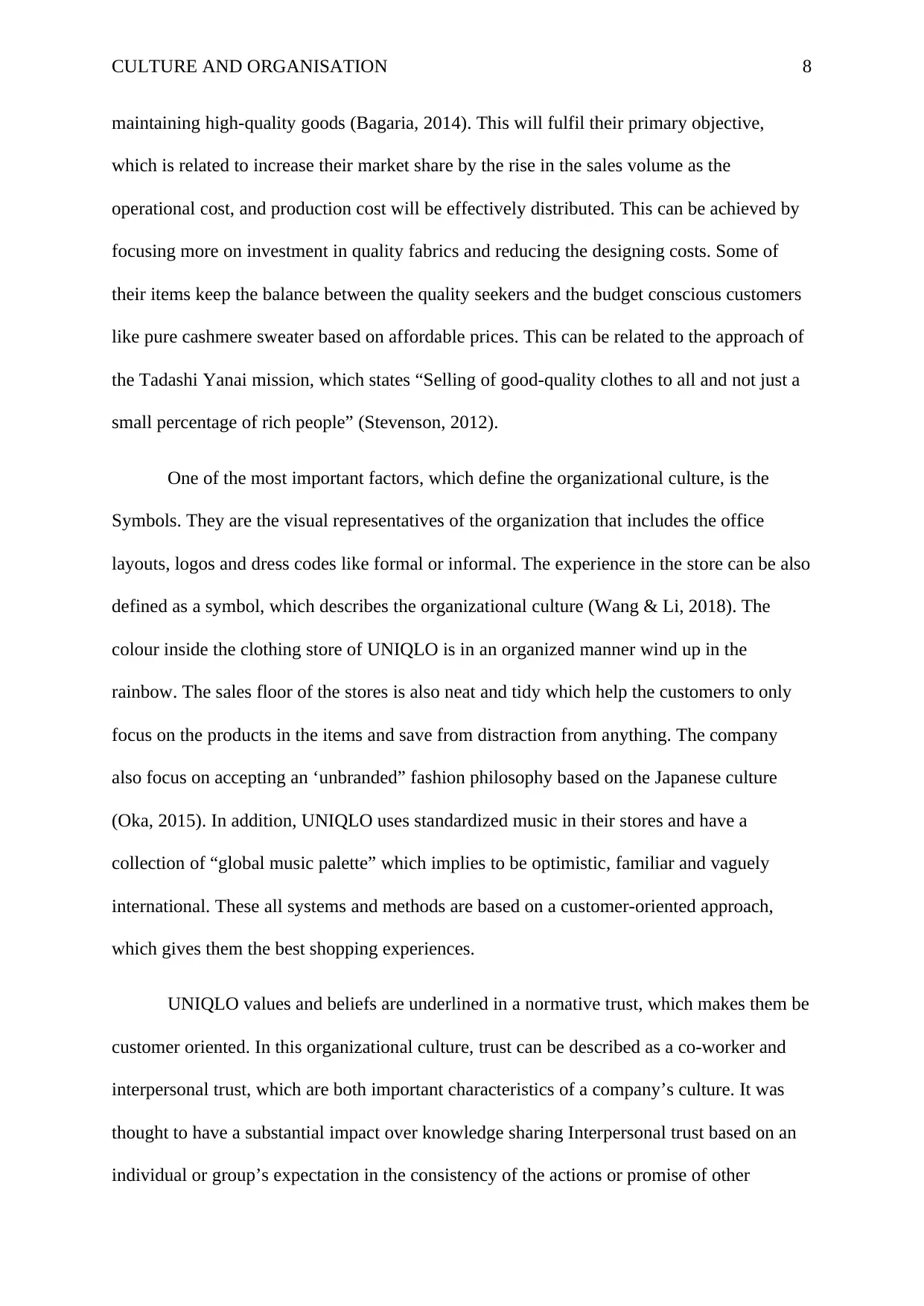
CULTURE AND ORGANISATION 8
maintaining high-quality goods (Bagaria, 2014). This will fulfil their primary objective,
which is related to increase their market share by the rise in the sales volume as the
operational cost, and production cost will be effectively distributed. This can be achieved by
focusing more on investment in quality fabrics and reducing the designing costs. Some of
their items keep the balance between the quality seekers and the budget conscious customers
like pure cashmere sweater based on affordable prices. This can be related to the approach of
the Tadashi Yanai mission, which states “Selling of good-quality clothes to all and not just a
small percentage of rich people” (Stevenson, 2012).
One of the most important factors, which define the organizational culture, is the
Symbols. They are the visual representatives of the organization that includes the office
layouts, logos and dress codes like formal or informal. The experience in the store can be also
defined as a symbol, which describes the organizational culture (Wang & Li, 2018). The
colour inside the clothing store of UNIQLO is in an organized manner wind up in the
rainbow. The sales floor of the stores is also neat and tidy which help the customers to only
focus on the products in the items and save from distraction from anything. The company
also focus on accepting an ‘unbranded” fashion philosophy based on the Japanese culture
(Oka, 2015). In addition, UNIQLO uses standardized music in their stores and have a
collection of “global music palette” which implies to be optimistic, familiar and vaguely
international. These all systems and methods are based on a customer-oriented approach,
which gives them the best shopping experiences.
UNIQLO values and beliefs are underlined in a normative trust, which makes them be
customer oriented. In this organizational culture, trust can be described as a co-worker and
interpersonal trust, which are both important characteristics of a company’s culture. It was
thought to have a substantial impact over knowledge sharing Interpersonal trust based on an
individual or group’s expectation in the consistency of the actions or promise of other
maintaining high-quality goods (Bagaria, 2014). This will fulfil their primary objective,
which is related to increase their market share by the rise in the sales volume as the
operational cost, and production cost will be effectively distributed. This can be achieved by
focusing more on investment in quality fabrics and reducing the designing costs. Some of
their items keep the balance between the quality seekers and the budget conscious customers
like pure cashmere sweater based on affordable prices. This can be related to the approach of
the Tadashi Yanai mission, which states “Selling of good-quality clothes to all and not just a
small percentage of rich people” (Stevenson, 2012).
One of the most important factors, which define the organizational culture, is the
Symbols. They are the visual representatives of the organization that includes the office
layouts, logos and dress codes like formal or informal. The experience in the store can be also
defined as a symbol, which describes the organizational culture (Wang & Li, 2018). The
colour inside the clothing store of UNIQLO is in an organized manner wind up in the
rainbow. The sales floor of the stores is also neat and tidy which help the customers to only
focus on the products in the items and save from distraction from anything. The company
also focus on accepting an ‘unbranded” fashion philosophy based on the Japanese culture
(Oka, 2015). In addition, UNIQLO uses standardized music in their stores and have a
collection of “global music palette” which implies to be optimistic, familiar and vaguely
international. These all systems and methods are based on a customer-oriented approach,
which gives them the best shopping experiences.
UNIQLO values and beliefs are underlined in a normative trust, which makes them be
customer oriented. In this organizational culture, trust can be described as a co-worker and
interpersonal trust, which are both important characteristics of a company’s culture. It was
thought to have a substantial impact over knowledge sharing Interpersonal trust based on an
individual or group’s expectation in the consistency of the actions or promise of other
⊘ This is a preview!⊘
Do you want full access?
Subscribe today to unlock all pages.

Trusted by 1+ million students worldwide
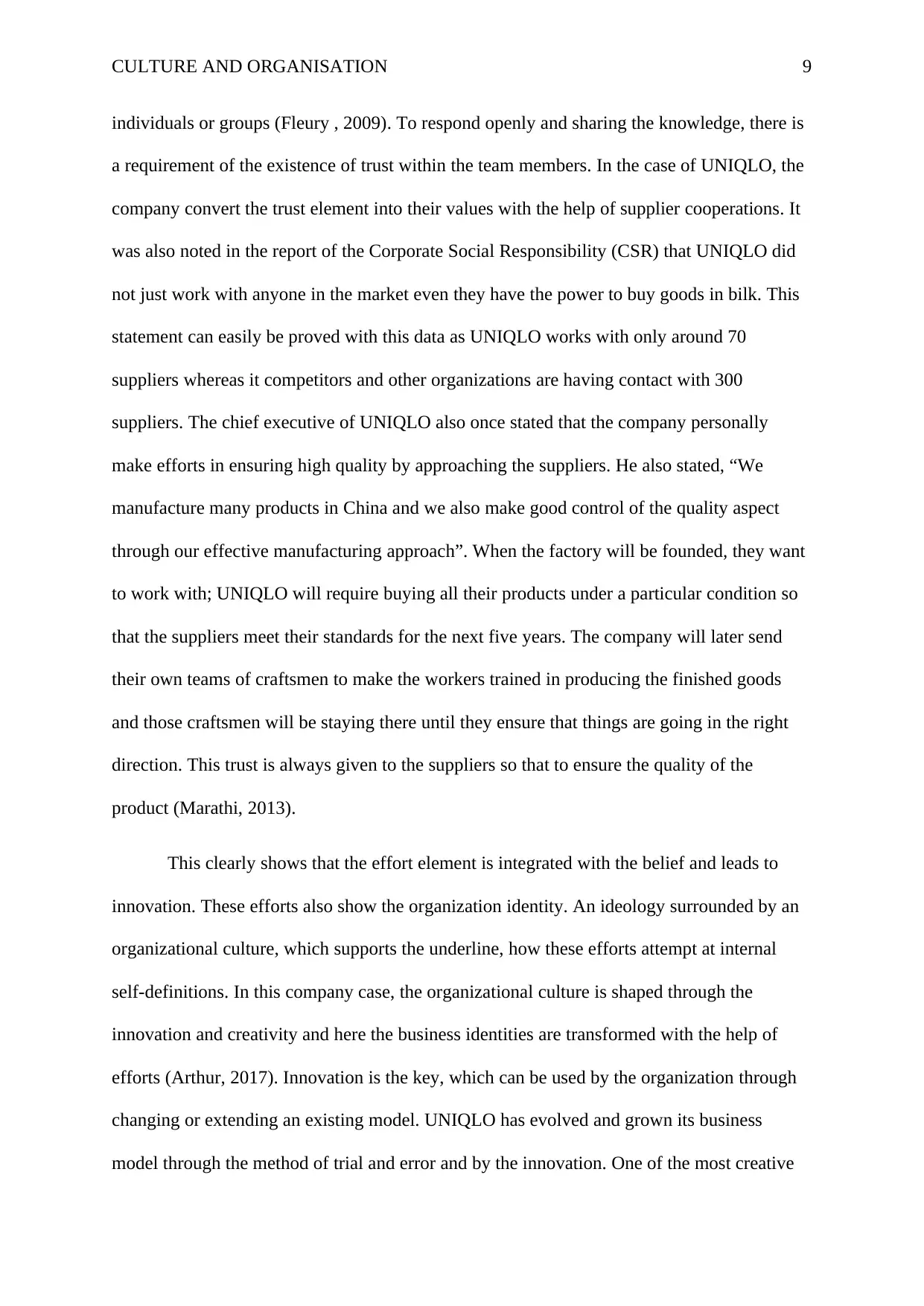
CULTURE AND ORGANISATION 9
individuals or groups (Fleury , 2009). To respond openly and sharing the knowledge, there is
a requirement of the existence of trust within the team members. In the case of UNIQLO, the
company convert the trust element into their values with the help of supplier cooperations. It
was also noted in the report of the Corporate Social Responsibility (CSR) that UNIQLO did
not just work with anyone in the market even they have the power to buy goods in bilk. This
statement can easily be proved with this data as UNIQLO works with only around 70
suppliers whereas it competitors and other organizations are having contact with 300
suppliers. The chief executive of UNIQLO also once stated that the company personally
make efforts in ensuring high quality by approaching the suppliers. He also stated, “We
manufacture many products in China and we also make good control of the quality aspect
through our effective manufacturing approach”. When the factory will be founded, they want
to work with; UNIQLO will require buying all their products under a particular condition so
that the suppliers meet their standards for the next five years. The company will later send
their own teams of craftsmen to make the workers trained in producing the finished goods
and those craftsmen will be staying there until they ensure that things are going in the right
direction. This trust is always given to the suppliers so that to ensure the quality of the
product (Marathi, 2013).
This clearly shows that the effort element is integrated with the belief and leads to
innovation. These efforts also show the organization identity. An ideology surrounded by an
organizational culture, which supports the underline, how these efforts attempt at internal
self-definitions. In this company case, the organizational culture is shaped through the
innovation and creativity and here the business identities are transformed with the help of
efforts (Arthur, 2017). Innovation is the key, which can be used by the organization through
changing or extending an existing model. UNIQLO has evolved and grown its business
model through the method of trial and error and by the innovation. One of the most creative
individuals or groups (Fleury , 2009). To respond openly and sharing the knowledge, there is
a requirement of the existence of trust within the team members. In the case of UNIQLO, the
company convert the trust element into their values with the help of supplier cooperations. It
was also noted in the report of the Corporate Social Responsibility (CSR) that UNIQLO did
not just work with anyone in the market even they have the power to buy goods in bilk. This
statement can easily be proved with this data as UNIQLO works with only around 70
suppliers whereas it competitors and other organizations are having contact with 300
suppliers. The chief executive of UNIQLO also once stated that the company personally
make efforts in ensuring high quality by approaching the suppliers. He also stated, “We
manufacture many products in China and we also make good control of the quality aspect
through our effective manufacturing approach”. When the factory will be founded, they want
to work with; UNIQLO will require buying all their products under a particular condition so
that the suppliers meet their standards for the next five years. The company will later send
their own teams of craftsmen to make the workers trained in producing the finished goods
and those craftsmen will be staying there until they ensure that things are going in the right
direction. This trust is always given to the suppliers so that to ensure the quality of the
product (Marathi, 2013).
This clearly shows that the effort element is integrated with the belief and leads to
innovation. These efforts also show the organization identity. An ideology surrounded by an
organizational culture, which supports the underline, how these efforts attempt at internal
self-definitions. In this company case, the organizational culture is shaped through the
innovation and creativity and here the business identities are transformed with the help of
efforts (Arthur, 2017). Innovation is the key, which can be used by the organization through
changing or extending an existing model. UNIQLO has evolved and grown its business
model through the method of trial and error and by the innovation. One of the most creative
Paraphrase This Document
Need a fresh take? Get an instant paraphrase of this document with our AI Paraphraser
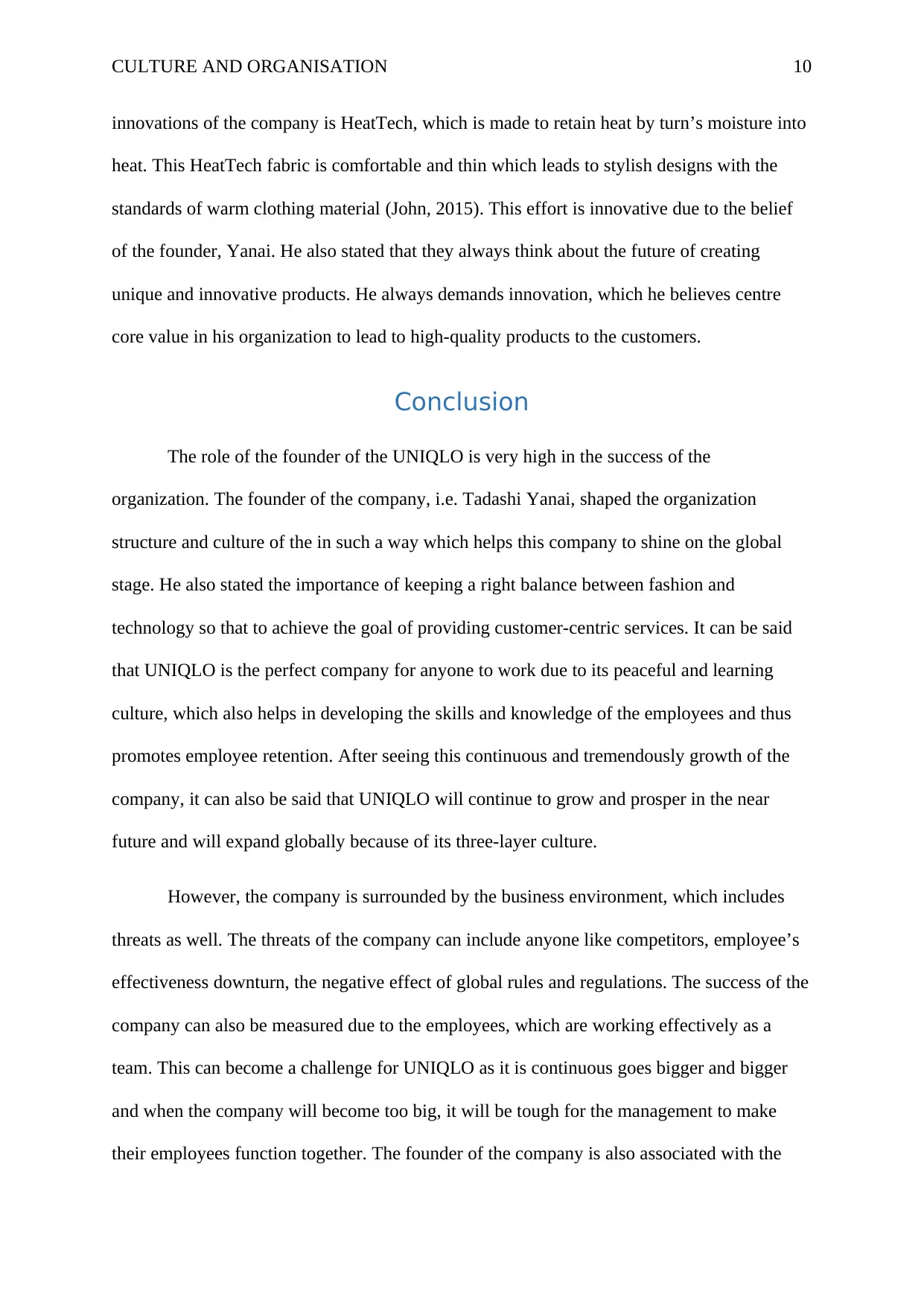
CULTURE AND ORGANISATION 10
innovations of the company is HeatTech, which is made to retain heat by turn’s moisture into
heat. This HeatTech fabric is comfortable and thin which leads to stylish designs with the
standards of warm clothing material (John, 2015). This effort is innovative due to the belief
of the founder, Yanai. He also stated that they always think about the future of creating
unique and innovative products. He always demands innovation, which he believes centre
core value in his organization to lead to high-quality products to the customers.
Conclusion
The role of the founder of the UNIQLO is very high in the success of the
organization. The founder of the company, i.e. Tadashi Yanai, shaped the organization
structure and culture of the in such a way which helps this company to shine on the global
stage. He also stated the importance of keeping a right balance between fashion and
technology so that to achieve the goal of providing customer-centric services. It can be said
that UNIQLO is the perfect company for anyone to work due to its peaceful and learning
culture, which also helps in developing the skills and knowledge of the employees and thus
promotes employee retention. After seeing this continuous and tremendously growth of the
company, it can also be said that UNIQLO will continue to grow and prosper in the near
future and will expand globally because of its three-layer culture.
However, the company is surrounded by the business environment, which includes
threats as well. The threats of the company can include anyone like competitors, employee’s
effectiveness downturn, the negative effect of global rules and regulations. The success of the
company can also be measured due to the employees, which are working effectively as a
team. This can become a challenge for UNIQLO as it is continuous goes bigger and bigger
and when the company will become too big, it will be tough for the management to make
their employees function together. The founder of the company is also associated with the
innovations of the company is HeatTech, which is made to retain heat by turn’s moisture into
heat. This HeatTech fabric is comfortable and thin which leads to stylish designs with the
standards of warm clothing material (John, 2015). This effort is innovative due to the belief
of the founder, Yanai. He also stated that they always think about the future of creating
unique and innovative products. He always demands innovation, which he believes centre
core value in his organization to lead to high-quality products to the customers.
Conclusion
The role of the founder of the UNIQLO is very high in the success of the
organization. The founder of the company, i.e. Tadashi Yanai, shaped the organization
structure and culture of the in such a way which helps this company to shine on the global
stage. He also stated the importance of keeping a right balance between fashion and
technology so that to achieve the goal of providing customer-centric services. It can be said
that UNIQLO is the perfect company for anyone to work due to its peaceful and learning
culture, which also helps in developing the skills and knowledge of the employees and thus
promotes employee retention. After seeing this continuous and tremendously growth of the
company, it can also be said that UNIQLO will continue to grow and prosper in the near
future and will expand globally because of its three-layer culture.
However, the company is surrounded by the business environment, which includes
threats as well. The threats of the company can include anyone like competitors, employee’s
effectiveness downturn, the negative effect of global rules and regulations. The success of the
company can also be measured due to the employees, which are working effectively as a
team. This can become a challenge for UNIQLO as it is continuous goes bigger and bigger
and when the company will become too big, it will be tough for the management to make
their employees function together. The founder of the company is also associated with the
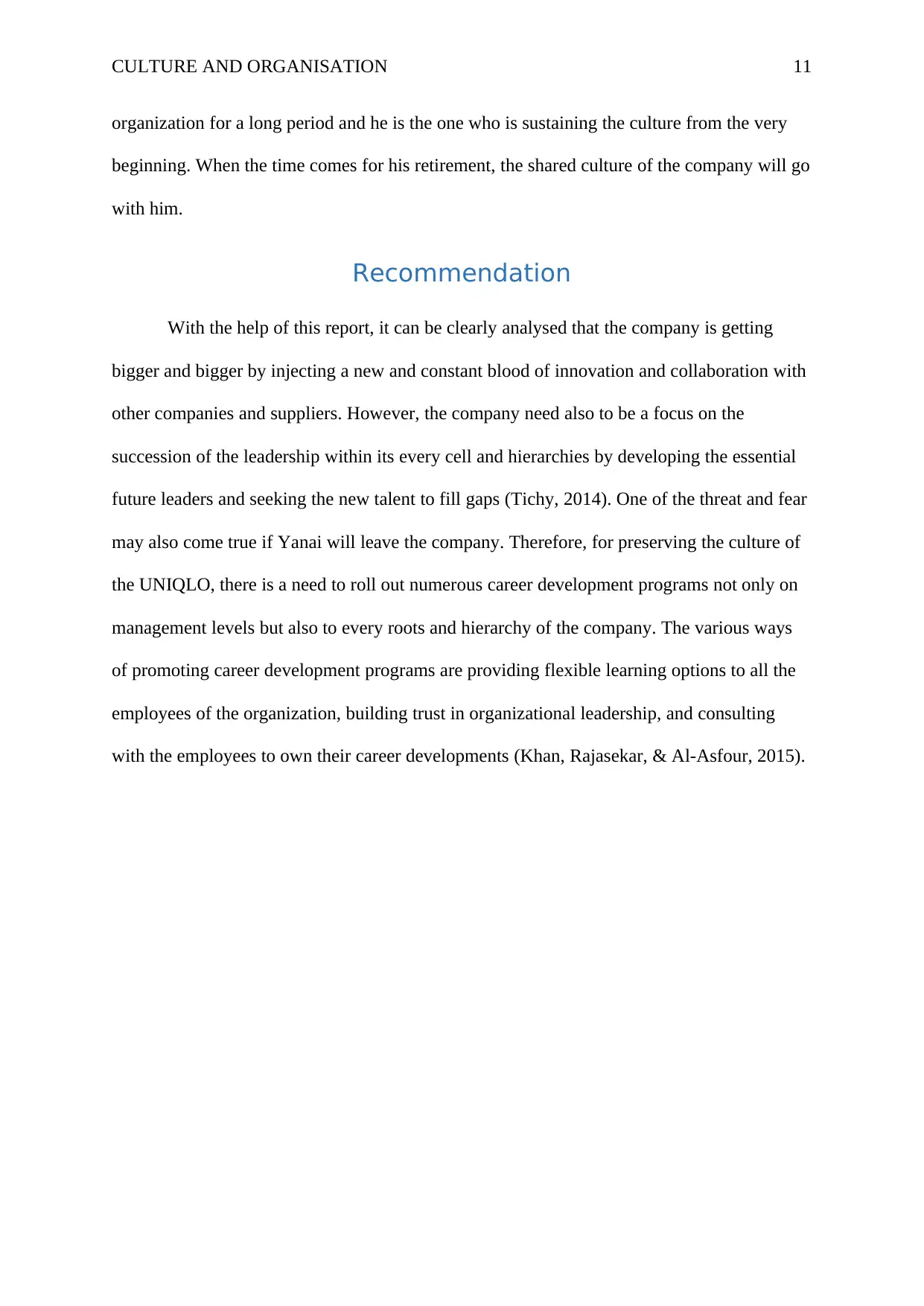
CULTURE AND ORGANISATION 11
organization for a long period and he is the one who is sustaining the culture from the very
beginning. When the time comes for his retirement, the shared culture of the company will go
with him.
Recommendation
With the help of this report, it can be clearly analysed that the company is getting
bigger and bigger by injecting a new and constant blood of innovation and collaboration with
other companies and suppliers. However, the company need also to be a focus on the
succession of the leadership within its every cell and hierarchies by developing the essential
future leaders and seeking the new talent to fill gaps (Tichy, 2014). One of the threat and fear
may also come true if Yanai will leave the company. Therefore, for preserving the culture of
the UNIQLO, there is a need to roll out numerous career development programs not only on
management levels but also to every roots and hierarchy of the company. The various ways
of promoting career development programs are providing flexible learning options to all the
employees of the organization, building trust in organizational leadership, and consulting
with the employees to own their career developments (Khan, Rajasekar, & Al-Asfour, 2015).
organization for a long period and he is the one who is sustaining the culture from the very
beginning. When the time comes for his retirement, the shared culture of the company will go
with him.
Recommendation
With the help of this report, it can be clearly analysed that the company is getting
bigger and bigger by injecting a new and constant blood of innovation and collaboration with
other companies and suppliers. However, the company need also to be a focus on the
succession of the leadership within its every cell and hierarchies by developing the essential
future leaders and seeking the new talent to fill gaps (Tichy, 2014). One of the threat and fear
may also come true if Yanai will leave the company. Therefore, for preserving the culture of
the UNIQLO, there is a need to roll out numerous career development programs not only on
management levels but also to every roots and hierarchy of the company. The various ways
of promoting career development programs are providing flexible learning options to all the
employees of the organization, building trust in organizational leadership, and consulting
with the employees to own their career developments (Khan, Rajasekar, & Al-Asfour, 2015).
⊘ This is a preview!⊘
Do you want full access?
Subscribe today to unlock all pages.

Trusted by 1+ million students worldwide
1 out of 14
Related Documents
Your All-in-One AI-Powered Toolkit for Academic Success.
+13062052269
info@desklib.com
Available 24*7 on WhatsApp / Email
![[object Object]](/_next/static/media/star-bottom.7253800d.svg)
Unlock your academic potential
Copyright © 2020–2025 A2Z Services. All Rights Reserved. Developed and managed by ZUCOL.




